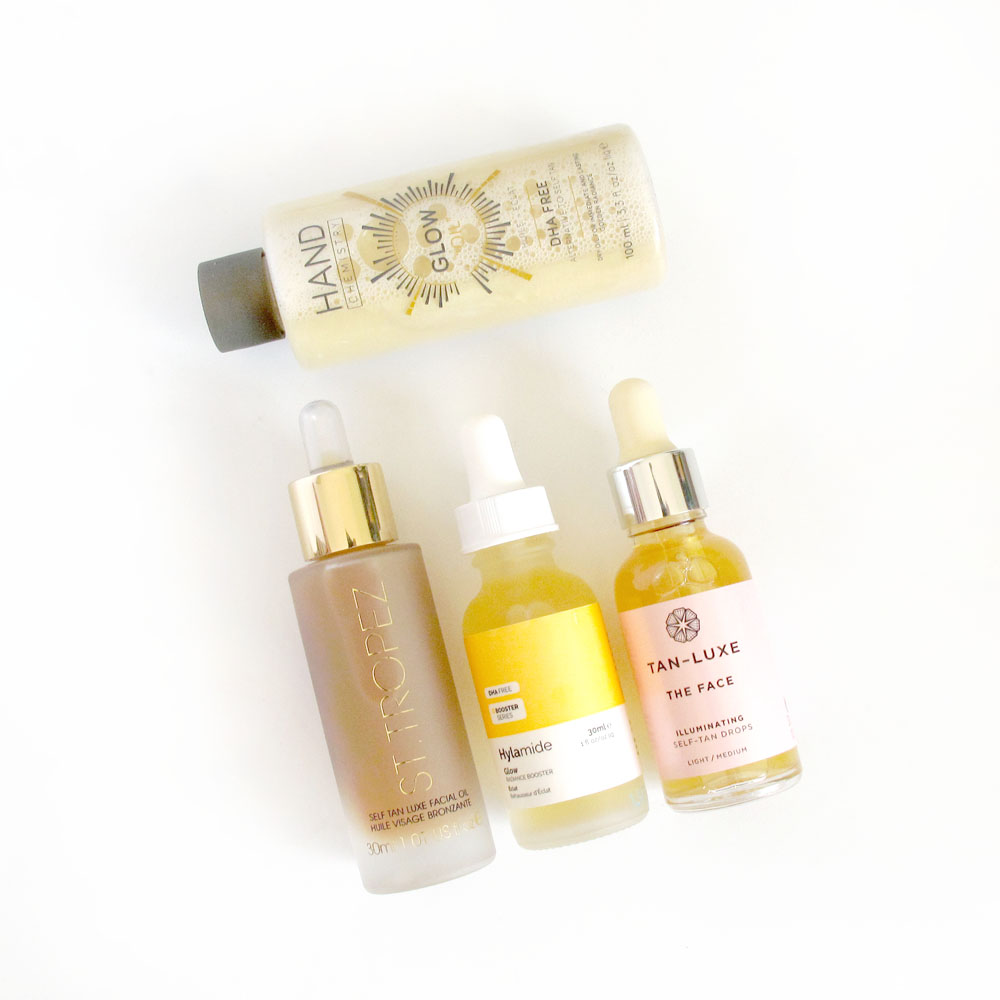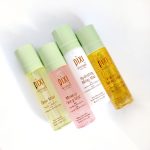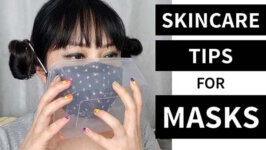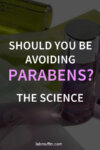My face is naturally darker than my body despite me using a ton of sunscreen, so I’ve been fake tanning in an effort to stop me from looking like a mime artist. But now I’ve gone too far and my body is usually a shade darker. While I could just use fake tan on my face, it feels wrong to use a body product there, like I’m just asking for a breakout, plus fake tan works best right on the skin and gradual tans are usually quite thick in texture. So I’ve been testing out some lighter products purposely designed for the face instead: Tan-Luxe The Face Raspberry & Rose Self-Tan Drops, Hylamide Glow Balance Booster and St Tropez Luxe Facial Tanning Oil. For comparison, I’ve also included Hand Chemistry which I’ve reviewed before, since I mostly used it on my face.
General notes
- The main ingredients in self-tanners are dihydroxyacetone (DHA) and erythrulose (often referred to as fruit ketone). They work much like the browning reaction that happens when cooking food. This reaction works best at low, skin-friendly pH values.
- Dihydroxyacetone has a bad reputation because of older versions where impure DHA caused the reaction to go more of an unnatural orange than yellow.
- Erythrulose is a newer fake tan ingredient that’s a bit larger than DHA, so it works slower but penetrates deeper and you end up with a more gradual tan that lasts longer. (Erythrulose was developed by someone who reads Lab Muffin – hello Roland if you’re reading this!)
- None of these are really “oils”, even when labelled as such – dihydroxyacetone and erythrulose are both water-soluble, so they’ll be in a mixture that’s mostly water.
- Most of these contain lots of humectants to counteract the drying effect that dihydroxyacetone and erythrulose.
- Make sure you wash your hands with soap after application! Fake tanner ingredients stick harder to dead skin, so you fingertips are really prone to staining.
- By the same token, make sure you don’t apply these products on dry patches of skin. Either avoid those spots, or apply a moisturiser on them to prevent patchy staining.
Tan-Luxe The Face Raspberry & Rose Self-Tan Drops
Tan-Luxe The Face Raspberry & Rose Self-Tan Drops (available from TVSN if you’re from Australia) is a product that’s designed to mix in with your regular cream or serum. You can add as many drops to adjust to the shade you want.
It’s $74.95 for a 30 mL bottle on TVSN which is on the pricey side, but you also end up using less product since you’ll only be using a few (2-3) drops each time. I only ever use 2 drops max, since I don’t want to wake up like an oompa loompa (yes, it will turn you orange if you don’t proceed with caution!). It’s mixed well with all the water-based serums and moisturisers I’ve used so far, but I expect that it doesn’t work that well with oilier products.
I found that it was quite easy to stuff up while applying this and end up streaky. Make sure you mix the tan drops evenly into your cream on your hand, and make sure you also apply it very evenly.
Scent-wise, it stands up to the claim that it doesn’t smell too strongly like DHA, but it’s still detectable. The product alone has a strong raspberry scent that I found a little offputting, but once diluted into a cream it was quite nice. It contains a few nourishing ingredients – glycerin, raspberry seed oil, rose geranium oil, vitamin E and aloe vera – but the fact you only use a few drops means they aren’t as effective. Just make sure you use a good moisturiser with it.
Ingredients: Aqua (Water), Dihydroxyacetone, Alcohol Denat. (Alcohol), Glycerin, Erythrulose, Rubus Idaeus (Raspberry) Seed Oil, Pelargonium Graveolens (Rose Geranium) Oil, Tocopheryl Acetate, Aloe Barbadensis (Aloe) Leaf Juice, Hydrolyzed Silk, Caramel, Polysorbate 80, Xanthan Gum, Parfum (Fragrance), Limonene, Geraniol, Hexyl Cinnamal, Benzyl Salicylate, Butylphenyl Methylpropional, Sodium Hydroxide, Benzoic Acid, Phenoxyethanol, Dehydroacetic Acid.
St Tropez Self Tan Luxe Facial Oil
St Tropez Self Tan Luxe Facial Oil uses dihydroxyacetone as the only tanning ingredient. It’s $39.99 for 30 mL which is a bit pricey, but I found that it worked faster than the non-DHA Deciem products. The colour was a natural looking golden brown. It’s a little sticky on the skin, but I usually go to bed with sticky skincare on my skin so I didn’t mind. It smells like citrus when you apply it, but turns into the usual fake tan smell after a while. I normally don’t mind the smell too much but on my face it got a bit annoying and I found myself using my most fragranced moisturisers to try to hide it. The smell largely goes away once you wash your face in the morning though.
Ingredients: Water, PEG-40 Hydrogenated Castor Oil, Dihydroxyacetone, PPG-15 Stearyl Ether, Bis-PEG-15 Methyl Ether Dimethicone, Propylene Glycol, Dimethyl Isosorbide, Phenoxyethanol, Potassium Sorbate, Bertholletia Excelsa Seed Oil, Citrus Grandis (Grapefruit) Peel Oil, Cymbopogan Flexuosus Oil, Limonene, Citral, Citrus Aurantium Amara (Bitter Orange) Flower Oil, Linalool, Geraniol, Caramel.
Hand Chemistry Glow “Oil”
I reviewed this previously, but I wanted to mention Hand Chemistry Glow “Oil” here to act as a comparison to Deciem’s other tanning product, Hylamide Glow Balance Booster. This is a DHA-free tanner that uses erythrulose (raspberry keto-sugar) as the skin-browning ingredient, for a slower-developing but longer-lasting tan. I used this on my face because it was a bit pricey and came in a really small bottle compared to other body tanners ($39.99 for 100 mL). My main issues were that it contained shimmer, which was weird for applying on your face before bed, and that it smelt way too sweet from the watermelon extract – probably not a big issue if you use it on your body, but on the face it’s a bit too much. It was sticky but also moisturising so I didn’t mind, and it didn’t streak. There wasn’t any sort of lingering scent either once I washed the watermelon sweetness away.
Ingredients: Propanediol, Aqua (Water), Erythrulose, Titanium Dioxide, Dimethyl Isosorbide, Ethoxydiglycol, Mica, PPG-26-Buteth-26, Glycerin, PEG-40 Hydrogenated Castor Oil, Parfum (Fragrance), Acetyl Hexapeptide-1, Citrulline, Citrullus Lanatus (Watermelon) Fruit Extract, Polypodium Vulgare Rhizome Extract, Cetraria Islandica Thallus Extract, Sphagnum Magellanicum Extract, Dextran, 1,2-Hexanediol, Caprylyl Glycol, Phytic Acid, Citric Acid, Sodium Benzoate, Potassium Sorbate, Phenoxyethanol, Tin Oxide, Citral, Citronellol, Eugenol, Farnesol, Geraniol, Limonene, Linalool.
Hylamide Glow Balance Booster
Hylamide Glow Balance Booster is Deciem’s tan product that’s actually designed to be used on your face (heh). Like Hand Chemistry Glow Oil, it doesn’t contain DHA and uses erythrulose (raspberry keto-sugar) instead. It doesn’t have the usual DHA smell either… and hurrah! No sugary watermelon smell either. In fact, it’s almost completely scentless. It’s also a lot less sticky than Glow Oil, and doesn’t contain shimmer. Essentially, it’s Glow Oil without the bits I didn’t like!
There are a few bonus ingredients too, like acetyl hexapeptide-1 (also known as melitane), which can stimulate the skin to produce melanin pigment without sun exposure, in a way similar to melanotan. There’s also oxidised glutathione which has been found to even out pigmentation and smooth out skin in a peer-reviewed manufacturer study. The downside compared to Glow Oil is that it’s more expensive – $39.99 for 30 mL.
Again, like Glow Oil, it takes a little longer to develop the tan colour (2-3 days vs overnight for St Tropez), and it’s recommended that you use it twice daily to build up colour (vs once daily with St Tropez). The final colour is a bit on the yellow side but very natural looking for me, and fades away evenly.
Ingredients: Aqua (Water), Erythrulose, Glycerin, PPG-26-Buteth-26, Propanediol, Acetyl Hexapeptide-1, Dextran, Ethoxydiglycol, Dimethyl Isosorbide, Oxidised Glutathione, Citrulline, Citrullus Lanatus (Watermelon) Fruit Extract, Polypodium Vulgare Rhizome Extract, Cetraria Islandica Thallus Extract, Sphagnum Magellanicum Extract, Lactobacillus/Eriodictyon Californicum Ferment Extract, Phytic Acid, Phospholipids, Acacia Senegal Gum, Xanthan Gum, Trisodium Ethylenediamine Disuccinate, PEG-40 Hydrogenated Castor Oil, Leuconostoc/Radish Root Ferment Filtrate, Potassium Sorbate, Sodium Benzoate, 1,2-Hexanediol, Caprylyl Glycol, Phenoxyethanol, Citric Acid, Linalool, Farnesol.
Verdict
I actually quite liked all of these products! My favourite at the moment is the Tan-Luxe drops. It has both DHA and erythrulose so you get speed as well as even fading, and the fact that it’s adjustable appeals to my love of customisation. However, the learning curve is a bit steep and you need to mix and apply it carefully, so if you’re self-conscious about streakiness I’d avoid it. If you want a more foolproof (or lazy-proof) product, I’d recommend St Tropez if you want speed and don’t mind DHA smell, and Hylamide or Hand Chemistry if you hate DHA smell and don’t mind waiting a bit for the colour to develop.
These products were provided for editorial consideration, which did not affect my opinion. This post also contains affiliate links – if you decide to click through and support Lab Muffin financially (at no extra cost to you), thank you! For more information, see Disclosure Policy.







Very helpful review! Thank you. I was wondering if fake tanners cause or affect the sun spots on skin that we try so hard to get rid of. Do they operate by the same mechanism?
Nope! Fake tanners just stain the very top layer of skin with something that’s the same colour as melanin, whereas sun spots are deeper deposits of melanin 🙂
I was going to check the same thing… rather terrified they’ll kick off my melasma more, but sounds as though I can go the full oompa-loompa. Excellent!! 😉
How are they different from bb/cc/tinted creams that are usually with spf? I mean im confused what is the function of this type of products? Are they beneficial to skin somehow?
a belated thank you for this rundown! i’m using a vitamin c “brightening” product from deciem (the ascorbyl tetra-something-something in vitamin F, idk) — and their 2% retinoids at night. do you think it’s counterproductive to use self-tanner alongside “brightening” ingredients that suppress melanin (vitamin C) and exfoliate the top layers of skin that the tanner is meant to work on (retinoids)? like wouldn’t these other ingredients counteract the tanner? really curious about your thoughts.
Exfoliants do make tanners fade faster, but if you keep using it the colour will keep showing up 🙂